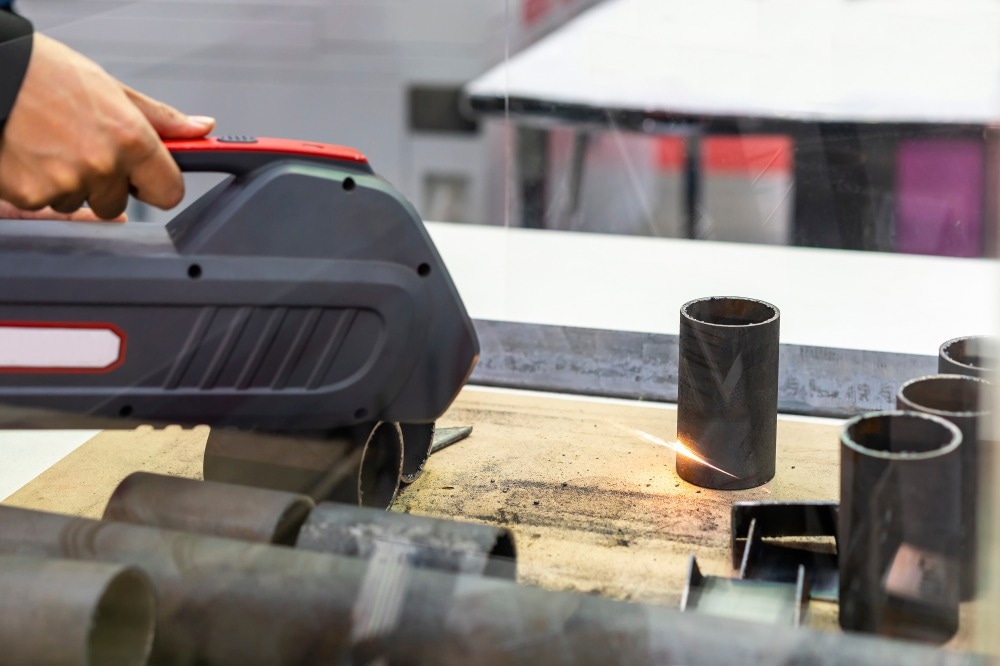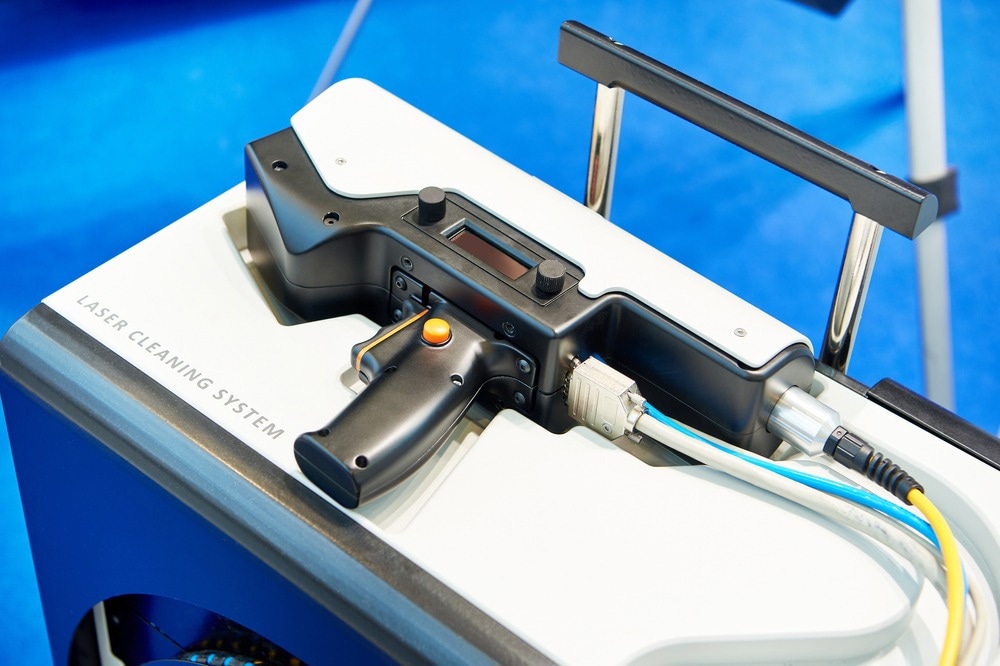In this article, the process of laser cleaning technology in the context of metal surface cleaning will be explored, including how it operates and why it is advantageous.

Image Credit: Surasak_Photo/Shutterstock.com
What is Laser Cleaning Technology?
Light amplification by stimulated emission of radiation (laser) is a monochromatic and coherent electromagnetic source that propagates in a straight line with negligible divergence. Currently, lasers are used in different material processing applications in the manufacturing sector, ranging from surface cleaning to nanofabrication.
Laser cleaning represents a non-destructive and non-contact cleaning method that allows the removal of surface contaminants from the bulk of the material in a controlled manner using a laser beam. Thus, laser cleaning machines are gradually becoming the equipment of choice for the containment removal process/cleaning.
The suitable laser type and optimal parameters differ for every cleaning application. The laser output parameters can be varied on a large scale in the laser cleaning method. Thus, specific laser output parameters can be selected based on the material/contaminant that has to be removed.
Steam cleaning and dry cleaning are the major types of laser cleaning methods used for surface contaminant removal. Dry laser cleaning involves pulse laser heating of a dry solid surface, while steam laser cleaning involves pulse laser heating of the solid surface in presence of a liquid layer.
Dry laser cleaning turns into evaporative cleaning when the energy of the incident laser pulse is increased. Although this technique is simple, dry cleaning is less effective compared to steam cleaning and requires a higher laser intensity. Moreover, dry laser cleaning can cause damage to the metal surface.
How Laser Cleaning Technology Functions
Laser cleaning is primarily a form of laser ablation that occurs when a material deposited on a surface or a layer of material is removed using a laser beam. Laser rust removal on steel and other materials is based on the laser ablation process.
However, laser ablation of material occurs only when the energy of the incident laser beam is higher than the ablation threshold of that material. Every material possesses a specific ablation threshold depending on its molecular bonds, and the threshold differs from other materials.
Thus, a material can be removed in a highly selective manner during laser cleaning without impacting the other material when the difference between the ablation thresholds of two materials is sufficiently large.
For instance, the ablation threshold of rust is significantly lower compared to the threshold of steel or aluminum, which allows the use of laser cleaning machines to completely vaporize the rust without damaging the underlying steel.

Image Credit: Sergey Ryzhov/Shutterstock.com
Although both pulsed and continuous laser beam-based cleaning processes can be used to remove a layer effectively, the speed of the process varies depending on the laser beam used for the cleaning.
The pulsed laser beam is more efficient and offers a faster removal speed compared to the continuous laser beam. Additionally, the use of a pulsed laser beam can prevent overheating of the underlying metal.
Advantages and Disadvantages of Laser Cleaning Technology
Laser cleaning is environmentally-friendly, consumable-free, and requires no chemical products or solvents as this method only uses a laser beam to vaporize a layer. Additionally, laser cleaning machines pose no risk to the operators as these machines are designed to meet all safety standards.
Other major advantages of using laser cleaning technology include high productivity, lack of mechanical damage on the surface, and remotability. Thus, laser cleaning is the safest method currently available for rust removal. However, the difficulty in discriminating the ablation thresholds between the substrate and the contaminant layer is a major disadvantage of this technology.
Types of Laser Cleaning Systems
Robotically controlled solid-state lasers utilized in tire mold cleaning displayed a higher cleaning speed compared to conventional abrasive cleaning methods. Similarly, a neodymium: yttrium aluminum garnet (Nd: YAG) laser cleaner was recently used to clear leaves from railway tracks. Nd: YAG lasers improve the flexibility of the cleaning process and are more reliable and free from operating faults compared to other lasers.
Large surface areas are laser cleaned using transversely excited atmosphere carbon dioxide (CO2) pulsed lasers with multi-kilowatts energy outputs. The 10.6 µm laser output length of these lasers makes them suitable for cleaning metal substrates as metals are highly reflective of this laser wavelength, which ensures the removal of only the organic containment. However, achieving a uniform energy distribution is difficult in high-power CO2 lasers.
Major Industrial Applications of Laser Cleaning Technology
Laser cleaning is typically used for rust removal and surface profiling in steel fabrication, anode assembly cleaning, preparation of adhesive bonding for metals, pretreatment for welding and brazing, partial de-coating, selective paint removal, and removal of dirt from metal mold surfaces.
New Studies on Laser Cleaning Technology
In a study published in the journal MATEC Web of Conferences, researchers experimentally investigated the effect of different key laser parameters, such as the number of passes and scan speed, on the depth of removal and surface properties, such as surface profile, hardness, and roughness, after laser cleaning.
A moving pulsed laser beam was used to irradiate the rusted mild steel samples. The depth of removal increased with the increasing laser power and number of scans and decreased with the increase in scan speed. The surface was deformed and discolored after laser cleaning at higher powers and lower speeds of the laser.
The final surface roughness and surface profile after laser processing were dependent on the laser scan patterns. Thus, the surface roughness values of the laser-cleaned parts were unrelated to the initial surface roughness values before laser cleaning.
Additionally, the surface hardness increased significantly after the laser treatment. The microhardness values varied with the scanning path of the laser beam, indicating changes in the microstructure due to the laser cleaning.
Single passes at higher speeds resulted in a well-cleaned surface, while multiple passes caused random changes in surface topology at lower speeds and specific changes in topology at higher speeds.
To summarize, unconventional laser cleaning technology has emerged as an eco-friendly and simple method and a suitable alternative to conventional cleaning processes to increase the effectiveness and quality of cleaning metal surfaces.
More from AZoM: Improving the Effectiveness of Laser Heat Treatment with Laser Beam Profiling
References and Further Reading
Hirmaz, M.S. (2019). Laser Cleaning of Metal Surfaces: A Review. International Journal of Scientific & Engineering Research, Volume 10, Issue 7. ISSN 2229-5518. https://www.ijser.org/researchpaper/Laser-Cleaning-of-Metal-Surfaces-A-Review.pdf
Marla, D., Singh, R. K., Narayanan, V. (2018). Laser cleaning for rust removal on mild steel: An experimental study on surface characteristics. MATEC Web of Conferences, 221, 01007. https://doi.org/10.1051/matecconf/20182210100
Disclaimer: The views expressed here are those of the author expressed in their private capacity and do not necessarily represent the views of AZoM.com Limited T/A AZoNetwork the owner and operator of this website. This disclaimer forms part of the Terms and conditions of use of this website.